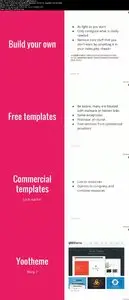Udemy – Joomla Performance and Speed
WEBRip | MP4/AVC, ~119 kb/s | 1280 x 720 | English: AAC, 56.2 kb/s (2 ch), 48.0 KHz | 529 MB
Genre: Development / Web Development | Language: English | +Project Files
WEBRip | MP4/AVC, ~119 kb/s | 1280 x 720 | English: AAC, 56.2 kb/s (2 ch), 48.0 KHz | 529 MB
Genre: Development / Web Development | Language: English | +Project Files
Fast Joomla websites, that is what this course is about. I will talk about optimizing the Joomla core settings, but also how third-party plugins and services can help you make your site even faster. As long as you know the basics of Joomla administration you should be able to follow this course.
The course takes 4 hours, with mainly video and some slide-presentations and is easy to follow for intermediate Joomla enthousiasts.
I will first explain why it is so important to have a fast website and also talk about your hosting environment before we jump into Joomla. Then we will optimize Joomla, using the caching and zipping-features inside the CMS. After having optimized Joomla and your hosting parameters we will discuss a number of plugins that make Joomla even faster. These plugins are about stuff like optimizing CSS and Javascript, using Content Delivery Networks, etcetera.
We will also discuss optimizing images, often the biggest resource part of a website. Finally, we will discuss optimizing for mobile devices.
In the end, you will no longer have a slow website, it will probably be more then twice as fast as it was!
What are the requirements?
- A basic understanding of Joomla administration
- Know the basics of setting plugin parameters
What am I going to get from this course?
- Over 46 lectures and 3.5 hours of content!
- Know the optimization options inside Joomla
- Choose plugins to enhance performance
- Make your Joomla website load screaming fast
What is the target audience?
- Users with slow sites
- Users with sites that perform well, but want further improvement
- Users that want to understand the concepts of a fast Joomla website
Curriculum
Section 1: Overview
Lecture 1 Introduction / about the instructor 01:45
I will introduce you to the course and to the trainer, Simon Kloostra.
Lecture 2 The importance of fast websites 02:47
The importance of a fast website is not just about a pleasant experience. It is also about conversion. Also, Google seems to like faster websites more.
Section 2: Measure your current performance
Lecture 3 The importance of measuring performance 02:43
You will have to know your starting point before you start optimizing your website. This will help you understand your actions.
There are many online tools that can help you measure your performance. All have their stronger and weaker points.
Lecture 4 GT Metrix Preview 07:32
GT-Metrix combines Google Pagespeed and Y-Slow performance, giving you 2 tools in one. You can use it anonymously, but a free account gives you some added functionality.
Lecture 5 Pingdom Tools 04:43
Pingdom Tools is another tool to measure website performance. Focus is a little bit different from GT-Metrix, but largely comparable. You can use it anonymously, but a free account gives you some added functionality.
Lecture 6 Google Pagespeed Insights 03:47
This is Google's too for performance measurement. Being from Google, it is obviously an important tool to use. Getting scores over 90% is very hard here, as it requires some very hard to take measures.
Lecture 7 Other performance tools and wrap up 05:11
There are some more performance tools that you can also use. Some are:
- Webpagetest
- DareBoost
- Loadimpact
- Y-Slow browser extension
- And probably more
Section 3: Setting your environment
Lecture 8 Take precautions for your site 01:27
Some of the improvements we will discuss could possibly harm your functionality. Therefor, make sure to keep track of what you are doing so you can retrace your steps, while making a backup is always a good idea.
Lecture 9 Hosting your Joomla website 03:34
Choosing a good webhost is crucial, as switching hosts with a live site is always a challenge. Also you may have to option to choose from different set-ups, like PHP-versions.
Section 4: Joomla core performance options
Lecture 10 Choose an efficient template 07:32
There are many Joomla template providers, both free and paid that have beautiful templates in stock. However, not all of these are built with performance in mind, so choose an efficient one.
Of course, you can always build your own, as optimized as you want.
Lecture 11 Be carefull when choosing your extensions 7.61 MB
Every extension that you install in your site adds resources. This may slow down your site, especially with large sliders and galleries.
Lecture 12 How external scripts can slow you down 03:23
External scripts are notorious for slowing down your site. Especially social media scripts (counters!) are heavy, but also webfonts and Analytics / Adsense scripts add up.
Lecture 13 Global Configuration settings: Caching and G-zip 02:18
Joomla has some core options for caching and G-zip that can speed it up. G-zip is dicussed here, caching in the next section.
Section 5: Joomla and Cache
Lecture 14 Global Configuration Cache 05:45
Some of the caching options in Joomla are found in the Global Configuration settings. These settings apply to the whole site, unless overriden on a more detailed level.
Lecture 15 Module Cache 02:45
For separate modules you can deviate from the global settings. This is useful for modules that don't play well with the default setting.
Lecture 16 System - Page Cache plugin 03:40
The System - Page Cache plugin is often overlooked, as it is hidden between the many Joomla plugins. It is very powerful, but also known to cause issues sometimes.
Lecture 17 Cleaning cache 03:01
Periodically, you may have to clean up your cache. This is necessary in situations where the cached views are not showing your refreshed content.
Lecture 18 Leverage Browser Caching 08:04
The previous caching functions work on the server-side, configured from within Joomla. Browser Caching is re-using earlier downloaded resources on the browser side. Settings are applied in your .htaccess file.
Section 6: Cache plugins
Lecture 19 NoNumber Cache Cleaner 07:53
The Nonumber Cache Cleaner plugin is perfect for cleaning your cache in an efficient way. Instead of in 4 or 5 steps you can now clean it up with just one click.
Also it can clean up more then the Joomla core cache: Siteground cache, CDN, etcetera.
Lecture 20 Jotcache 09:07
JotCache replaces the Joomla System - Page Cache plugin, allowing for more fine-grained caching. It also allows for exclusion of components, modules and individual pages that work better without cache.
Lecture 21 Siteground Supercacher 04:56
For those with sites hosted by Siteground you can use the Supercacher functionality that is available on all their accounts, also shared hosting. It allows for even faster sites and is easy to deploy.
Section 7: Optimize your images
Lecture 22 Introduction to optimized images 01:50
Images are often the largest portion of a website's resources. This makes it very important to make them as light as possible, or even use alternatives.
Lecture 23 Photoshop options / prepare your images locally 03:49
Images should be prepared before they are uploaded to the website. They should be created in exactly the size needed and be saved as small as possible.
Lecture 24 Lossless / Lossy compression 04:41
Lossless or lossy compression is a very efficient way of stripping off unneeded data of images, without any loss in quality at all, or just slightly. There are free compressors around on the web, while ImageRecycle even provides a Joomla plugin for this.
Lecture 25 Base-encode small images 04:08
Images can sometimes be replaced by base-encoding. This means that you will just use a representation in HTML-code that allow the browser to generate an image. For every encoded image this saves you one HTTP-request.
Lecture 26 Other techniques: Sprites, background-images, responsive images. lazy load 04:10
Other techniques for optimizing images are sprites, responsive images and clever use of the background-images technique, while there will be more techniques around as well.
Section 8: Joomla extensions for optimizing images
Lecture 27 Joomla Content Editor (JCE) 03:53
Many Joomla users use the JCE editor as a replacement for TinyMCE. For paid users, it allows for an additional plugin that can resize your images while uploading them.
Lecture 28 Lazy Load for Joomla 03:58
Lazy Load for Joomla by Kubik Rubik extensions use the lazy-load technique to only load images above the fold for initial display. Only when scrolling down those images will actually be loaded.
Lecture 29 ImageRecycle Preview 05:08
ImageRecycle allows for free lossless compression on their website, but they also have a Joomla plugin that allows you to perform the optimization from within Joomla, either automatic or on request.
Lecture 30 XT Adaptive Images 04:46
XT Adaptive Images is a plugin that will create separate versions of each image, sized specifically for either desktop, tablet or mobile usage.
Section 9: Optimize CSS and Javascript files
Lecture 31 Introduction to optimizing CSS and Javascript 03:27
We need to understand the concepts of CSS and Javascript optimization first. Especially combination and compression of these resources is what this is all about.
Lecture 32 Mootools Enabler / Disabler 03:21
Mootools Enabler / Disabler removes the heavy Mootools script that is currently still loaded in Joomla, though many sites don't need it. You can completely remove it with this extension, or set it to load under certain conditions, like front-end editing, or certain pages.
Lecture 33 JCC - JS CSS Control 03:55
Based on filename, you can remove any script or CSS-file that you don't want. This is very nice for files that you know of are actually unused.
Lecture 34 JCH-Optimize 09:29
JCH-Optimize is a very popular plugin that can basically perform all the optimizations for you. You can configure all options, setting it to basic or aggrive optimization, or anything in between.
Lecture 35 Yireo ScriptMerge 07:10
Yireo Scriptmerge is a plugin that basically does the same optimizations as JCH-Optimize, with slighly different accents.
Lecture 36 Other performance plugins: JBetolo, RokBooster 03:50
Next to the discussed ones, there are some more plugins like this, like RokBooster, Jbetolo, Too Many Files, etcetera.
Section 10: Content Delivery Networks
Lecture 37 Introduction to CDN's 04:43
If you set up a CDN for your website, your content will be served from the closest location available for each user. This is especially useful for sites targeting a global audience, or users in larger countries like the USA, Russia, etcetera.
Lecture 38 CDN Providers 02:51
First, you will have to choose a CDN-provider. There are many good ones, but you need at least one that integrates will with Joomla.
Lecture 39 Cloudflare implementation Preview 04:50
Cloudflare is a popular CDN that offers multiple free basic accounts. Also it is very easy to set up, usually sraight from your Cpanel.
Lecture 40 MaxCDN implementation 03:25
MaxCDN is also a very popular CDN that provides very good performance. Implementation is really easy and can be done in 2 minutes.
Lecture 41 Set up Joomla for your CDN provider 03:13
After you have set up your CDN on the CDN-provider side, you should also configure Joomla for this. To do so, there are a number of plugins, but especially CDN for Joomla by NoNumber is really good for this.
Lecture 42 Set up a custom domain for your CDN 03:02
To make the best of your CDN, a custom domain to serve your files from is usually best, especially for SEO purposes. This can be done from your Cpanel.
Section 11: Optimize for mobile devices
Lecture 43 Introduction to mobile performance 05:12
Why is mobile performance so important? More and more people are using smartphones to watch websites, currently more then 50% already, and not all of these benefit from goof wifi or 4G connections, while also the phone itself might be of an older model that might be slow to render your site.
Google also encourages efficient mobile sites and might even reward those with better rankings.
Lecture 44 Extensions for Mobile Performance 06:31
You need to serve mobile users with optimized content. There are many techniques for this, while there are also a few Joomla plugins that can help you with that.
Section 12: Finishing off
Lecture 45 Measure again! 00:45
Now that your site is optimized, measure again to see what you gained. Hopefully the site has become much lighter and faster!
Lecture 46 Check your functionality 01:42
Just one more thing. Check very careful that all aspects of your sites still work. Especially look at dynamic functionality like contact forms, shopping carts, etcetra, and also check the mobile version of your site.
LabView - Collective Books
Mega E-books Pack (2013)
Malware Centric E-book Collection
Huge Electricity, Magnetism, A..., Healing - EBooks Collection
Premium IT eBooks Collection
Huge Encyclopedias - EBooks Collection
Osprey Publishing - Military History Books Collection
Gale Encyclopedias - Full Pack
IT Books Collection (Basic - Intermediate - Advance)
Medicinal and Aromatic Plants - 50 Volume Set
Doctor Who ebooks Collection
Learning HTML Ultimate Collection
Comprehensive Robotics Books Collection
Great Royal Web Design Pack
Civil Engineering Geotechnical books
Luftwaffe Colours Collection
Many Thanks to Original uploader.
For More Rare Movies Check out my blog!
Download Links:
No Mirrors Please





